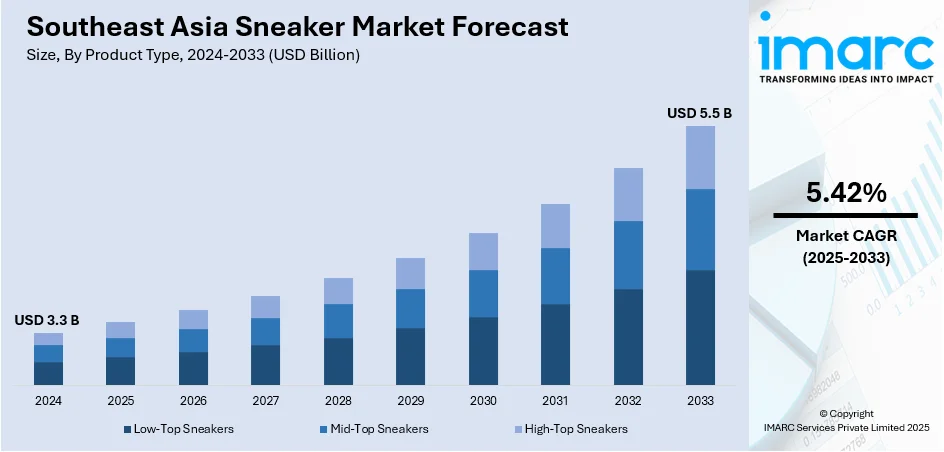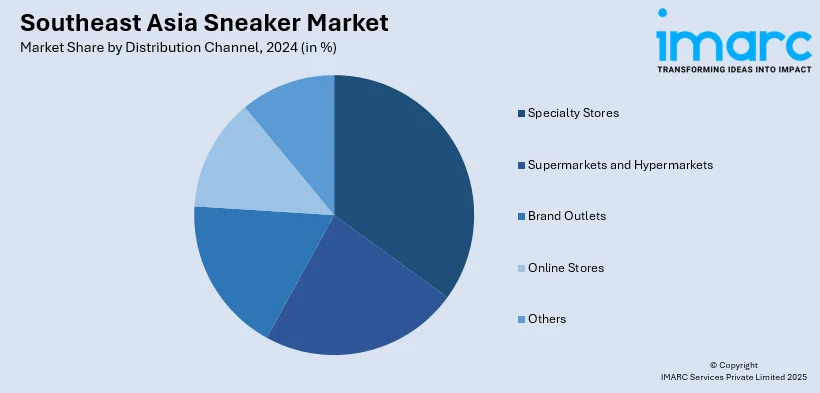
Southeast Asia Sneaker Market Size, Share, Trends and Forecast by Product Type, Category, Price Point, Distribution Channel, End User, and Country, 2025-2033
Market Overview:
Southeast Asia sneaker market size reached USD 3.3 Billion in 2024. Looking forward, IMARC Group expects the market to reach USD 5.5 Billion by 2033, exhibiting a growth rate (CAGR) of 5.42% during 2025-2033. The rising participation in fitness activities, along with the widespread adoption of improved and breathable materials, is primarily driving the regional market.
|
Report Attribute
|
Key Statistics
|
|---|---|
|
Base Year
|
2024 |
|
Forecast Years
|
2025-2033
|
|
Historical Years
|
2019-2024
|
| Market Size in 2024 | USD 3.3 Billion |
| Market Forecast in 2033 | USD 5.5 Billion |
| Market Growth Rate (2025-2033) | 5.42% |
Sneakers, commonly utilized for outdoor activities, are typically crafted from canvas with a rubber sole. The sole, flexible in nature, is constructed using leather, synthetic fabrics, and mesh, and undergoes specialized manufacturing processes. These shoes find extensive use in physical pursuits like running, walking, sports, and everyday casual wear. Engineered to deliver support and cushioning during diverse activities, sneakers are often fashioned from breathable materials. Typically paired with casual attire such as jeans or shorts, they play a crucial role in averting injuries by providing ankle support, minimizing the risk of twists and rolls. Beyond injury prevention, sneakers offer notable features like excellent traction and support for the arch, heel, and toe, contributing to slip and fall prevention.

To get more information on this market, Request Sample
Southeast Asia Sneaker Market Trends:
The Southeast Asia sneaker market is witnessing a dynamic surge, reflecting the region's evolving fashion trends, increasing emphasis on active lifestyles, and the widespread adoption of athleisure. These shoes cater to a diverse range of activities, from running and walking to sports and everyday casual wear, aligning with the region's dynamic lifestyle preferences. Additionally, in Southeast Asia, sneakers are not merely utilitarian but have evolved into fashion statements, often paired with casual clothing like jeans or shorts. Besides this, the market is characterized by a plethora of designs, colors, and collaborations between international and local brands, catering to the discerning tastes of consumers. Moreover, the emphasis on health and fitness has significantly contributed to the growth of the sneaker market in Southeast Asia. Beyond fashion, sneakers are chosen for their ability to provide support, cushioning, and ankle stability during physical activities, preventing injuries and ensuring comfort. With the incorporation of advanced materials and technology, sneakers in the Southeast Asia market offer not only style but also functionality, making them a sought-after footwear choice across various demographics. Apart from this, as the region continues to embrace a culture that values both style and wellness, the Southeast Asia sneaker market is poised for sustained growth and innovation over the forecasted period.
Southeast Asia Sneaker Market Segmentation:
IMARC Group provides an analysis of the key trends in each segment of the market, along with forecasts at the regional and country levels for 2025-2033. Our report has categorized the market based on product type, category, price point, distribution channel, and end user.
Product Type Insights:
- Low-Top Sneakers
- Mid-Top Sneakers
- High-Top Sneakers
The report has provided a detailed breakup and analysis of the market based on the product type. This includes low-top sneakers, mid-top sneakers, and high-top sneakers.
Category Insights:
- Branded
- Private Label
A detailed breakup and analysis of the market based on the category have also been provided in the report. This includes branded and private label.
Price Point Insights:
- Luxury
- Economic
The report has provided a detailed breakup and analysis of the market based on the price point. This includes luxury and economic.
Distribution Channel Insights:

- Specialty Stores
- Supermarkets and Hypermarkets
- Brand Outlets
- Online Stores
- Others
A detailed breakup and analysis of the market based on the distribution channel have also been provided in the report. This includes specialty stores, supermarkets and hypermarkets, brand outlets, online stores, and others.
End User Insights:
- Men
- Women
- Kids
The report has provided a detailed breakup and analysis of the market based on the end user. This includes men, women, and kids.
Country Insights:
- Indonesia
- Thailand
- Singapore
- Philippines
- Vietnam
- Malaysia
- Others
The report has also provided a comprehensive analysis of all the major regional markets, which include Indonesia, Thailand, Singapore, Philippines, Vietnam, Malaysia, and Others.
Competitive Landscape:
The market research report has also provided a comprehensive analysis of the competitive landscape. Competitive analysis such as market structure, key player positioning, top winning strategies, competitive dashboard, and company evaluation quadrant has been covered in the report. Also, detailed profiles of all major companies have been provided. Some of the key players include:
- Adidas AG
- ASICS Corporation
- ECCO Sko A/S
- Nike Inc.
- Puma SE
- Under Armour Inc.
(Please note that this is only a partial list of the key players, and the complete list is provided in the report.)
Southeast Asia Sneaker Market Report Coverage:
| Report Features | Details |
|---|---|
| Base Year of the Analysis | 2024 |
| Historical Period | 2019-2024 |
| Forecast Period | 2025-2033 |
| Units | Billion USD |
| Scope of the Report | Exploration of Historical and Forecast Trends, Industry Catalysts and Challenges, Segment-Wise Historical and Predictive Market Assessment:
|
| Product Types Covered | Low-Top Sneakers, Mid-Top Sneakers, High-Top Sneakers |
| Categories Covered | Branded, Private Label |
| Price Points Covered | Luxury, Economic |
| Distribution Channels Covered | Specialty Stores, Supermarkets and Hypermarkets, Brand Outlets, Online Stores, Others |
| End Users Covered | Men, Women, Kids |
| Countries Covered | Indonesia, Thailand, Singapore, Philippines, Vietnam, Malaysia, Others |
| Companies Covered | Adidas AG, ASICS Corporation, ECCO Sko A/S, Nike Inc., Puma SE, Under Armour Inc., etc. (Please note that this is only a partial list of the key players, and the complete list is provided in the report.) |
| Customization Scope | 10% Free Customization |
| Post-Sale Analyst Support | 10-12 Weeks |
| Delivery Format | PDF and Excel through Email (We can also provide the editable version of the report in PPT/Word format on special request) |
Key Benefits for Stakeholders:
- IMARC’s industry report offers a comprehensive quantitative analysis of various market segments, historical and current market trends, market forecasts, and dynamics of the Southeast Asia sneaker market from 2019-2033.
- The research report provides the latest information on the market drivers, challenges, and opportunities in the Southeast Asia sneaker market.
- Porter's five forces analysis assist stakeholders in assessing the impact of new entrants, competitive rivalry, supplier power, buyer power, and the threat of substitution. It helps stakeholders to analyze the level of competition within the Southeast Asia sneaker industry and its attractiveness.
- Competitive landscape allows stakeholders to understand their competitive environment and provides an insight into the current positions of key players in the market.
Key Questions Answered in This Report
The sneaker market in Southeast Asia was valued at USD 3.3 Billion in 2024.
The Southeast Asia sneaker market is projected to exhibit a CAGR of 5.42% during 2025-2033, reaching a value of USD 5.5 Billion by 2033.
The Southeast Asia sneaker market is driven by rising youth population, growing interest in fashion and streetwear culture, and increased social media influence. Expanding e-commerce platforms, rising disposable incomes, and urbanization support the demand. Additionally, collaborations and limited-edition releases increase user interest, while fitness trends and casual wear acceptance enhance market penetration across diverse demographics.
Some of the major players in the sneaker market include Adidas AG, ASICS Corporation, ECCO Sko A/S, Nike Inc., Puma SE, Under Armour Inc, etc.
Need more help?
- Speak to our experienced analysts for insights on the current market scenarios.
- Include additional segments and countries to customize the report as per your requirement.
- Gain an unparalleled competitive advantage in your domain by understanding how to utilize the report and positively impacting your operations and revenue.
- For further assistance, please connect with our analysts.
 Request Customization
Request Customization
 Speak to an Analyst
Speak to an Analyst
 Request Brochure
Request Brochure
 Inquire Before Buying
Inquire Before Buying




.webp)




.webp)












